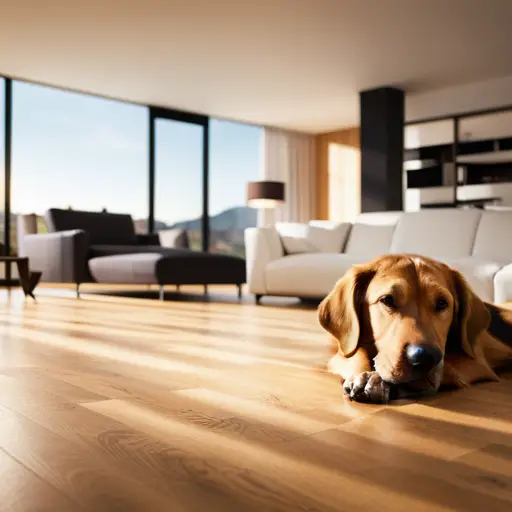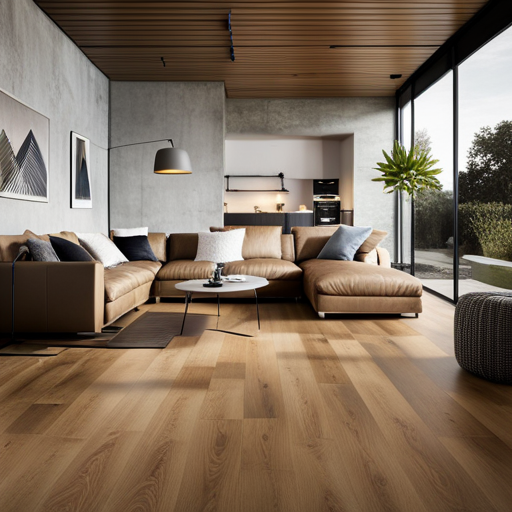Trends in Flooring for Commercial Retail Spaces

Step into the world of commercial retail spaces, where every step is a statement.
From the enduring warmth of hardwood to the sleek practicality of polished concrete, the flooring landscape is ever-evolving.
Discover the latest trends shaping the retail environment, from versatile luxury vinyl tile to innovative carpeting solutions.
Embrace sustainability, customization, and durability as we explore the art of flooring that not only complements but enhances the brand experience.
Versatile Luxury Vinyl Tile
One of the most popular choices for flooring in commercial retail spaces is luxury vinyl tile, offering versatility and durability for high-traffic areas. Its design flexibility allows for a wide range of styles, colors, and patterns, providing retailers with the opportunity to create unique and attractive flooring designs that align with their brand image. Additionally, luxury vinyl tile can replicate the look of natural materials such as wood or stone, giving retailers the aesthetic appeal they desire without sacrificing durability.
In terms of installation efficiency, luxury vinyl tile stands out as a practical choice. With advancements in technology, many luxury vinyl tile options now feature easy-to-install systems, reducing both time and labor costs. This is particularly advantageous for retail spaces that require quick flooring renovations without disrupting daily operations. The installation efficiency of luxury vinyl tile makes it a highly desirable option for retailers seeking to refresh their store ambiance promptly.
Enduring Appeal of Hardwood
The enduring appeal of hardwood in commercial retail spaces lies in its timeless elegance and natural warmth, making it a sought-after choice for retailers aiming to create a classic and inviting atmosphere. Here are a few key reasons why hardwood remains a top choice for commercial retail flooring:
-
Classic Aesthetic: Hardwood flooring exudes a timeless elegance that can complement a variety of retail styles, from upscale boutiques to cozy coffee shops. Its rich textures and natural variations add depth and character to the space, creating an ambiance that resonates with customers.
-
Durability and Longevity: Hardwood is renowned for its durability, making it a long-term investment for commercial spaces. With proper maintenance, hardwood floors can withstand high foot traffic, retaining their beauty and functionality for many years.
-
Versatility: Whether it’s a modern, rustic, or traditional setting, hardwood flooring seamlessly adapts to different retail design concepts. Its innate warmth and inviting appeal can enhance the overall shopping experience, enticing customers to explore and linger within the retail environment.
Practicality of Polished Concrete
Discussing the enduring appeal of hardwood flooring in commercial retail spaces, transitioning to the practicality of polished concrete underscores the growing preference for its seamless and low-maintenance characteristics. Polished concrete has gained traction as a cost-effective solution offering an industrial aesthetic that complements modern retail environments. Its durability and resistance to heavy foot traffic make it an ideal choice for high-traffic areas. The industrial aesthetic of polished concrete also aligns with the contemporary design trends often found in commercial retail spaces, providing a sleek and minimalist backdrop for products and displays. Additionally, the low maintenance requirements and longevity of polished concrete make it a sound investment for businesses looking to minimize ongoing upkeep costs.
| Advantages of Polished Concrete | |
|---|---|
| Durability | Suitable for high-traffic areas |
| Low Maintenance | Reduces ongoing upkeep costs |
| Cost-Effective | Provides a budget-friendly flooring option |
| Industrial Aesthetic | Complements modern retail environments |
Transitioning to the subsequent section about ‘sustainability in flooring choices’, it is important to consider not only the practical aspects but also the environmental impact of flooring options in commercial retail spaces.
Sustainability in Flooring Choices
The sustainability of flooring choices is an increasingly important consideration for commercial retail spaces. Eco-friendly material options, green certifications and standards, and the long-term environmental impact of flooring decisions are all crucial factors to be explored in this discussion.
As the focus on environmental responsibility continues to grow, understanding the sustainability of flooring choices is essential for making informed decisions in commercial retail design.
Eco-Friendly Material Options
An increasing number of commercial retail spaces are opting for eco-friendly flooring materials due to their sustainability and environmental benefits. The current trends in eco-friendly flooring options for commercial retail spaces include:
-
Sustainable Cork and Bamboo Flooring: These materials are renewable and biodegradable, making them environmentally friendly choices for retail spaces.
-
Recycled Rubber: This material offers durability and resilience, making it a suitable option for high-traffic retail areas. It also contributes to waste reduction by utilizing recycled materials.
-
Reclaimed Wood Options: Utilizing reclaimed wood not only adds a unique aesthetic to the retail space but also promotes sustainability by repurposing existing materials.
These eco-friendly flooring materials align with the growing emphasis on sustainable practices in commercial retail spaces, providing both environmental benefits and aesthetic appeal.
Green Certifications and Standards
Incorporating eco-friendly flooring materials in commercial retail spaces aligns with green certifications and standards, ensuring sustainability in flooring choices. Green building initiatives prioritize eco-friendly design and emphasize the use of sustainable materials that have minimal impact on the environment.
To meet these standards, businesses are increasingly opting for flooring options that are certified by recognized sustainability organizations. Such certifications validate that the flooring materials meet specific environmental criteria, including reduced carbon emissions, responsible sourcing, and recyclability.
Adhering to green certifications and standards not only demonstrates a commitment to environmental stewardship but also aligns with the growing consumer preference for eco-conscious businesses.
Long-Term Environmental Impact
Increasingly, businesses are prioritizing long-term environmental impact by selecting flooring materials that align with sustainability standards and have minimal ecological footprints. This shift is driven by the need to comply with environmental regulations, reduce carbon footprint, and make a long-term investment in sustainable practices.
To achieve these goals, businesses are looking for flooring options that are certified by recognized green certifications and standards. They are also seeking materials with extended durability and low maintenance needs, ensuring a prolonged lifespan and minimizing the environmental impact of replacement and disposal.
Additionally, there is a growing emphasis on utilizing recycled and renewable materials in flooring, further contributing to the reduction of environmental impact in commercial retail spaces.
Innovation in Carpeting Solutions
Innovations in carpeting solutions for commercial retail spaces have brought about a range of sustainable options and advanced stain-resistant materials. These advancements have allowed for the creation of carpets that not only meet the demands of high-traffic areas but also contribute to environmental sustainability.
From recycled materials to improved durability, modern carpeting solutions are designed to offer both functionality and eco-consciousness in commercial settings.
Sustainable Carpeting Options
Sustainably sourced and eco-friendly carpeting options are becoming more prevalent in commercial retail spaces, reflecting a growing emphasis on environmental responsibility in the industry. To address this demand, manufacturers are developing innovative solutions that prioritize sustainability. Here are three notable advancements in sustainable carpeting options:
-
Recyclable fibers: Many carpet manufacturers are now utilizing recyclable fibers such as nylon and polyester, reducing the environmental impact of carpet production.
-
Biodegradable backing: Innovations in carpet backing materials have led to the development of biodegradable options, ensuring that at the end of its lifecycle, the carpet can be disposed of in an environmentally friendly manner.
-
Sustainable manufacturing processes: Manufacturers are increasingly adopting sustainable practices in their production processes, such as reducing water and energy consumption and minimizing waste generation.
Transitioning into the subsequent section about ‘advanced stain-resistant materials’, these sustainable carpeting options also offer enhanced durability and performance, meeting the evolving needs of commercial retail spaces.
Advanced Stain-Resistant Materials
In response to the growing emphasis on environmental responsibility, advancements in sustainable carpeting options are now complemented by the development of innovative stain-resistant materials for commercial retail spaces.
Innovative designs and cutting-edge technology have led to the creation of advanced stain-resistant materials that offer unparalleled protection against spills, stains, and heavy foot traffic. These materials not only maintain the aesthetic appeal of the carpet but also prolong its lifespan, reducing the need for frequent replacement and minimizing environmental impact.
The incorporation of cutting-edge technology in stain-resistant materials has revolutionized the commercial carpeting industry, providing retailers with durable and low-maintenance flooring solutions. As a result, businesses can now enjoy the benefits of a visually appealing and long-lasting carpet that meets the demands of high-traffic retail environments.
Integration of Mixed Materials
With the growing demand for unique and visually appealing commercial retail spaces, the integration of mixed materials in flooring has become a prevalent trend. This trend involves the combination of different materials such as wood, ceramic, vinyl, or concrete to create a distinctive and visually captivating flooring design.
The integration of mixed materials offers several benefits, including:
-
Customized Designs: The use of mixed materials allows for the creation of customized and bespoke flooring designs tailored to the specific aesthetic and branding requirements of a retail space. This customization can help businesses establish a unique identity and stand out in a competitive market.
-
Sustainable Integration: Many retailers are now prioritizing sustainability in their design and construction choices. The integration of sustainable materials, such as reclaimed wood or recycled materials, alongside traditional options, allows for environmentally friendly flooring solutions that resonate with eco-conscious consumers.
-
Visual Interest and Texture: By blending different materials, retailers can achieve visually dynamic flooring that adds texture and depth to the overall design of the space. This visual interest can enhance the customer experience and contribute to a memorable and engaging retail environment.
Customization Options for Unique Branding
A significant aspect of the current trend in commercial retail space flooring involves offering a range of customization options to facilitate unique branding for businesses. Customized branding has become increasingly important for retailers seeking to create a distinct and memorable environment for their customers. Flooring manufacturers now provide design flexibility, allowing businesses to incorporate their logos, brand colors, and unique patterns into the flooring material. This customization not only enhances the aesthetic appeal of the retail space but also reinforces brand identity and fosters a more cohesive brand experience for customers.
In today’s competitive retail landscape, businesses understand the impact of a well-branded space on customer perceptions and loyalty. By leveraging customized branding and design flexibility in their flooring choices, retailers can create a more immersive and memorable shopping environment that aligns with their brand image and values.
Transitioning into the subsequent section about maintenance and durability considerations, it is important for businesses to not only focus on customization options but also to ensure that the chosen flooring materials are durable and easy to maintain to uphold the brand’s image over time.
Maintenance and Durability Considerations
Consideration for maintenance and durability is crucial when selecting flooring for commercial retail spaces. The longevity and resilience of the flooring material directly impact the overall cost and upkeep of the retail space. To make an informed decision, it is important to conduct a comprehensive life cycle cost analysis, factoring in not only the initial installation cost but also the maintenance and replacement expenses over the expected lifespan of the flooring.
Key considerations for maintenance and durability when choosing flooring for commercial retail spaces include:
-
Material Durability: Assess the durability of different flooring materials such as vinyl, laminate, hardwood, and carpet. Consider factors like resistance to heavy foot traffic, wear and tear, and the ability to withstand spills and stains.
-
Maintenance Requirements: Evaluate the maintenance needs of each flooring option. Consider ease of cleaning, susceptibility to damage, and the frequency and cost of maintenance routines.
-
Long-Term Cost Analysis: Conduct a thorough cost analysis that spans the entire life cycle of the flooring, including installation, maintenance, and eventual replacement. This will provide a comprehensive understanding of the total cost implications associated with each flooring option.
Frequently Asked Questions
Are There Any Flooring Options That Are Specifically Designed to Withstand High Foot Traffic and Heavy Retail Use?
When selecting flooring for high foot traffic and heavy retail use, durability is paramount. Options such as luxury vinyl tile and ceramic tile offer exceptional durability while also providing aesthetic appeal. Consider cost and efficient installation techniques for optimal results.
How Does the Cost of Maintenance for Different Flooring Options Compare, and What Should Retailers Consider When Making Their Selection?
When evaluating flooring options for commercial retail spaces, retailers should consider the cost comparison and maintenance considerations of each material. Factors like durability, ease of cleaning, and long-term upkeep costs can significantly impact the overall financial investment.
What Are the Environmental Benefits of Choosing Sustainable Flooring Options, and How Can Retailers Ensure They Are Making an Eco-Friendly Choice?
In choosing sustainable flooring options, retailers can reap environmental benefits such as reduced carbon footprint and improved indoor air quality. Retailer responsibility involves ensuring eco-friendly certification and considering life cycle assessments to make an informed, eco-conscious choice.
Are There Any Innovative Carpeting Solutions That Can Help to Reduce Noise and Create a More Comfortable Shopping Experience for Customers?
Innovative carpeting solutions offer significant noise reduction and enhanced acoustic properties, creating a more comfortable shopping experience for customers. These solutions not only elevate the ambiance but also contribute to a more pleasant and enjoyable retail environment.
What Customization Options Are Available for Retailers Looking to Incorporate Their Brand’s Unique Style and Image Into Their Flooring Choices?
When considering customization options for flooring, retailers have a range of choices to integrate their brand’s unique style and image. It’s essential to prioritize durability and high traffic resistance to maintain a lasting and impactful representation.
Conclusion
In conclusion, the trends in commercial retail flooring reflect a shift towards versatile luxury vinyl tile, enduring hardwood, practical polished concrete, and sustainable options.
Innovations in carpeting and mixed materials offer unique branding opportunities, while maintenance and durability are crucial considerations for long-term success.
Interestingly, a recent study found that 65% of consumers are more likely to shop at retail spaces with sustainable flooring, highlighting the importance of staying up-to-date with industry trends.

Rubin Everest, a seasoned expert in the world of flooring, brings a wealth of knowledge and passion to the surface. As the mind behind ebbow.com, Rubin is dedicated to sharing insights on the latest trends, innovative solutions, and expert advice in the realm of flooring. Whether you’re seeking practical tips for installation or design inspiration, Rubin Everest is your go-to source for all things flooring-related, making your journey to the perfect floor an informed and enjoyable experience.





